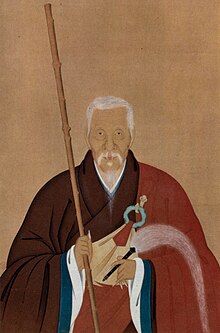| Ingen Ryūki | |
|---|---|
| Yinyuan Longqi | |
 Portrait of Ingen Ryūki from 1671 Portrait of Ingen Ryūki from 1671 | |
| Personal life | |
| Born | Lin Zengbing (1592-12-07)December 7, 1592 Fuqing, Fujian, Ming dynasty |
| Died | May 19, 1673(1673-05-19) (aged 80) Uji, Kyōto, Japan |
| Religious life | |
| Religion | Buddhism |
| School | Chan |
| Lineage | Linji school |
Ingen Ryūki (traditional Chinese: 隱元隆琦; pinyin: Yǐnyuán Lóngqí; Japanese: 隠元隆琦) (December 7, 1592 – May 19, 1673) was a Chinese poet, calligrapher, and monk of Linji Chan Buddhism from China. He is most known for founding the Ōbaku school of Zen in Japan.
Biography
Ingen was born on December 7, 1592, in Fuqing, Fujian, during China's Ming dynasty. Ingen's father disappeared when he was five. At age 20, while searching for him, Ingen arrived at Mount Putuo off Zhejiang province, where he served tea to monks. At 28, after the death of his mother, he was ordained as a monk at his family temple - Wanfu Temple, Mount Huangbo, Fujian. Ingen's teachers there were Miyun Yuanwu and Feiyin Tongrong. In 1633 he received dharma transmission from the latter, and in 1637 served his first term as abbot. His second term as 33rd abbot of the temple began in 1646 and at this time he is credited with helping Mount Huangbo to develop into a thriving Buddhist centre.
In 1654, after repeated requests of Itsunen Shoyu, he went to Nagasaki, Japan with around 30 monks and artisans, including his disciple Muyan. He founded the Ōbaku school of Zen. He established the Ōbaku head temple Manpuku-ji at Uji, Kyoto in 1661.
On May 21, 1673 (Enpō 1, 5th day of the 4th month), he died at Mampuku-ji.
Calligraphy
Ingen was a skilled calligrapher, introducing the Ming style of calligraphy to Japan. Along with his disciples Muyan and Sokuhi Nyoitsu, he was one of the Ōbaku no Sanpitsu ("Three Brushes of Ōbaku"). He is known to have carried paintings by Chen Xian with him to Japan.
Selected work
Ingen's published writings encompass 35 works in 46 publications in 4 languages and 226 library holdings.
This is a dynamic list and may never be able to satisfy particular standards for completeness. You can help by adding missing items with reliable sources.- 1979 — Complete Works of Ingen (新纂校訂隱元全集, Shinsan kōtei Ingen zenshū, OCLC 019817244)
See also
Notes
- ^ Nussbaum, Louis-Frédéric. (2005). "Ingen" in Japan encyclopedia, p. 387., p. 387, at Google Books; n.b., Louis-Frédéric is pseudonym of Louis-Frédéric Nussbaum, see Deutsche Nationalbibliothek Authority File Archived 2012-05-24 at archive.today.
- Titsingh, Isaac. (1834). Annales des empereurs du japon, p. 414., p. 414, at Google Books
- WorldCat Identities Archived 2010-12-30 at the Wayback Machine: 隱元 1592-1673
References
- Nussbaum, Louis Frédéric and Käthe Roth. (2005). Japan Encyclopedia. Cambridge: Harvard University Press. ISBN 978-0-674-01753-5; OCLC 48943301
- Titsingh, Isaac. (1834). Annales des empereurs du Japon. Paris: Oriental Translation Fund of Great Britain and Ireland. OCLC 251800045; see also Imprimerie Royale de France, OCLC 311322353
| Ming Dynasty Buddhists | |
|---|---|
- Qing dynasty Buddhist monks
- Obaku Buddhists
- Zen Buddhist abbots
- 17th-century abbots
- 1592 births
- 1673 deaths
- Chinese Zen Buddhists
- Rinzai Buddhists
- Ming dynasty calligraphers
- Qing dynasty calligraphers
- Writers from Fuzhou
- Artists from Fuzhou
- Poets from Fujian
- Qing dynasty poets
- Chan Buddhist monks
- Ming dynasty Buddhist monks
- 17th-century Buddhist monks
- Chinese tea masters
- Buddhist artists
- Edo period Buddhist clergy
- 17th-century Chinese calligraphers
- 17th-century Japanese calligraphers